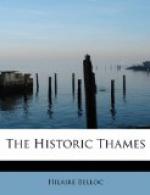It is, nevertheless, true that the last few miles of tidal water, in Western Europe at least, are not to be included in this first division of a great river.
The swish of the tide continues up beyond the broad estuary, the sand-banks, and the marshes, and there are reaches more or less long (rather less than twenty miles perhaps originally in the case of the Thames, rather more perhaps originally in the case of the lower Seine) which for the purposes of habitation are inland reaches. They have the advantage of a current moving in either direction twice a day and yet not the disadvantage of greatly varying levels of water. Thus one may say of the Seine in the old days that from about Caudebec to Point de L’Arche it enjoyed such inland tidal conditions; and of the Thames from Greenwich to Teddington that similar advantages existed.
The true point of division which separates, so far as human history is concerned, the lower from the upper part of such rivers is the first bridge, and, what almost always accompanies the first bridge, the first great town. To repeat the obvious parallel, Rouen was this point upon the Seine; upon the Thames this point was the Bridge of London. It is with the habitable and historic Thames Valley above the bridge that this book has to deal, and it will later be to the reader’s purpose to consider why London Bridge crossed the stream just where it did, and of what moment that site has been in the history of the Thames and of England.
The second division in a great European tidal river, considered as a means of communication, is the navigable but non-tidal portion.
The word navigable is so vague that it requires some definition before we can apply it to any particular stream. It does not, of course, mean in this connection “navigable by sea-going boats.” One may take a constant depth of so little as three feet to be sufficient for the purpose of carrying merchandise even in considerable bulk.
The legislatures of various countries have established varying gauges to determine where the navigability of a river may be said to cease. In practice these gauges have always been arbitrary. The upper reaches of a river may present sufficient depth but too fast a current, or they may be too narrow, or the curves may be too rapid, or the obstruction of rocks too common, for any sort of navigation, although the depth of water be sufficient.
Conversely, in some streams of peculiar breadth and constancy very shallow upper reaches may have early been converted to the use of man. The matter is only to be determined by the experience of what the inhabitants of a river valley have actually been able to do under the local circumstances, and when we examine this we shall usually be astonished to see how far inland a river was used until the history of internal navigation was transformed by the development of canals or partially destroyed by the development of railways. Thus it is certain that so small a stream as the Adur in Sussex floated barges up to the boundaries of Shipley Parish; that the Stour was habitually used beyond Canterbury; that so tiny a tributary as the Ant in Norfolk was followed up from its parent Bure to the neighbourhood of Worsted.




